gunnaknow
Active member
a vacuum flask is actually not used to keep butane liquid...u may b getting confused w something else...a vac flask is a standard glass flask (diff sizes) with a vac tube connector coming off one side of the column part...you attach a buchner funnel with filter to the top of the flask with a stopper and then turn on the vacuum..now instead of letting your shit drip through a coffee filter w gravity its pulled w vacuum into the vacuum flask...... anyways just wanted to clear that up..i think gunna know had mentioned something about a vac flask keeping gas liquid like as in under vacuum? maybe he meant?
heres a link to a thread w a vacc flask...its used for filtering ..
https://www.icmag.com/ic/showthread.php?t=232295&page=2
the flask with the big white funnel on top
Hi Waxmasta, the thing is that both a Buchner flask and a Dewar flask are sometimes known as a vacuum flask, even though they are completely different in design. In the case of butane extraction, we are referring to the latter meaning. A Dewar flask or Thermos flask is known as a vacuum flask because it has a partial vacuum between an inner and outer wall, which acts as an almost perfect insulator. They're routinely used in labs to store and transport liquid gases. Thankyou for raising an excellent point, I hope that this clarifies what we mean when we're referring to vacuum flask extraction.


 ). just my take it doesn't work as volatile at removing product in an open system, but you get a purer product. Pack your tube betterm throw in 3 grams pack it, 3 more grams pack it and so on. my tube can fit 30 grams but I find it works better with 20 pack it down TIGHT. I sometimes run 10 grams the space above doesn't matter. STRAINS are very important. If its done giving, throw in the towel. 2nd and runs always have more mass but less weight...find your happy medium. I always choose quality over quantity.
). just my take it doesn't work as volatile at removing product in an open system, but you get a purer product. Pack your tube betterm throw in 3 grams pack it, 3 more grams pack it and so on. my tube can fit 30 grams but I find it works better with 20 pack it down TIGHT. I sometimes run 10 grams the space above doesn't matter. STRAINS are very important. If its done giving, throw in the towel. 2nd and runs always have more mass but less weight...find your happy medium. I always choose quality over quantity.



